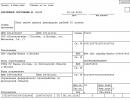Whiskered bat description. Red Book


Whiskered bat- Myotis mystacinus Kuhl, 1817
Order Chiroptera - Chiroptera
Family Smooth-nosed bats - Vespertilionidae
Category, status. 3 - rare view. Included in the Red Books of the Leningrad and Smolensk regions, the republics of Belarus, Estonia, and Latvia. It is protected by the Berne Convention (Appendix II). Guarded in Western Europe, Moldova, Ukraine, Belarus, the Baltic republics under the 1991 Agreement on the Conservation of Populations of European Bats (EUROBATS).
Short description. Small bat. Body length 39-46 mm. Forearm length 30-35 mm. The wingspan is 19-23 cm. The color of the back is dark, brownish-brown. The underparts are grayish tones. The fur is thick and long. The epiblema is undeveloped. The wing membrane is attached to the base of the outer toe. By external signs difficult to distinguish from Brandt's bat.
Area and distribution. Distributed throughout Europe, northern Africa, Southwestern and Central Asia east to Mongolia; in Russia - the south and east of the European part, the Caucasus, Southern Urals and Northern Caspian region, mountainous regions of the southern Western and Eastern Siberia, Transbaikalia. Inhabits different landscapes from forest zones to deserts (1).
In the Pskov region it is known from the discovery of two females in the village of Trutnevo, Gdovsky district (2).
Habitats and biological features. It settles in tree hollows and human buildings. Departure late, active all night. It occurs singly or forms small colonies. Flies out to hunt in the thick twilight. It feeds over forest roads, clearings, park alleys, over ponds, and along forest edges. The flight is fast and maneuverable. Mating after the end of lactation or during wintering. At the end of June - beginning of July, the female gives birth to one cub. A sedentary species that does not migrate long distances.
Species abundance and limiting factors. There are no long-term observations of the distribution and condition of the population. Limiting factors include: low reproductive capacity, cutting down of hollow trees, disturbance in the areas where brood colonies are located and wintering areas.
Security measures. Organization of specially protected natural areas on wintering grounds and in places where brood colonies are located.
Information sources:
1. Pavlinov et al., 2002; 2. Chistyakov, 2002; author's data.
Compiled by: D. V. Chistyakov.

Myotis mystacinus Kuhl, 1819
Order Chiroptera - Chiroptera Family Smooth-nosed bats, or Common bats - Vespertilionidae
Short description. Small bat. The color on the back is brown. The fur is slightly disheveled and uneven. The wing membrane is attached to the base of the outer toe of the hind limb. The length of the foot does not exceed half the length of the lower leg. There is no epiblem. The ear is extended along the head and protrudes 1-3 mm beyond the tip of the nose. The apex of the ear is narrow, mastoidally elongated. A notch on the outer edge and 4-5 transverse folds are clearly visible. The tragus is pointed, evenly tapering towards the apex, exceeding half the length of the auricle. The base of the tragus and the inner edge of the ear are the same color as the entire auricle.
Habitats and biology. Most of finds are confined to the mountain-steppe landscape. In the Irkutsk region, the only find was made on the river. Urik. Biology has been poorly studied. Known shelters in the Chita region are confined to outbuildings or rock cracks. Lives in small groups of 3 to 18 animals. There is usually one cub per litter. Emerges late, but often occurs at dusk. Active all night. It hunts by flying at a height of 1-6 m, usually above water bodies and near the crowns of trees. The flight is fast, with rather sharp turns. The young will be born in June-July. In the northern regions it flies south for the winter [b].
Spreading. Widespread Paleoarctic species. Inhabits Europe, North-West Africa and open landscapes of Asia to Mongolia and North-East China. In the Irkutsk region, one reliable find is known in 1959 in the Cheremkhovo district on the river. Urik. It is possible that this species includes encounters with bats in the Nizhneudinsky region in the Bol cave. Nizhneudinskaya and in the Olkhonsky district in the vicinity of the village. Small Kocherikovo (3). No winter finds are known in the Irkutsk region. No bone remains were found in the caves.
Number. Low, isolated occurrences in the Irkutsk region. In the Chita region in the steppe areas it is more common and is second in number only to the two-colored leatherback.
Limiting factors. Not known, due to the fact that the species is located on the outskirts of its range. It's possible negative impact fires and deforestation, as well as the destruction of temporary shelters from dry trees with hollows and loose bark.
Accepted and recommended security measures. No special protection measures have been developed. Need to find out current state species and, if new habitats are discovered, take measures to protect them. Attraction bats by hanging birdhouses and other artificial shelters in forests.
Information sources: 1 - Botvinkin, 2002; 2 - Catalog..., 1989; 3 - Lyamkin, 1983; 4 - Ovodov, 1972; 5 - Rosina, Kirilyuk, 2000; b - Flint et al., 1970.
Compiled by: V.V. Popov.
Artist: D.V. Kuznetsova.
The long-whiskered bat is a small bat found throughout Europe. This type was classified only in 1970 due to its significant similarity with the Mustached bats, which are also often confused with water bats. Both species live in similar conditions and have common visually identifiable characteristics. How to distinguish mustachioed bats from their relatives? Photos of these amazing animals, as well as their detailed description especially for you in our article.
Whiskered bat: photo and description of the species
This is one of eleven species of bats found in Russia. Whiskered bats belong to the family of smooth-nosed bats of the order Chiroptera. These bats are distributed throughout Europe, from Iran and North Africa to Mongolia. Sometimes representatives of the species are found in Southeast Asia. Animals of this species usually lead and only in the northernmost areas of their habitat can they move to more southern areas with the onset of cold weather. The whiskered bat, like most of its relatives, is active in the dark and rests in a shelter during the day.
Distinctive features of the species

Whiskered bats are small. The body size of a representative of this species is 35-48 mm, and the weight is 4-9 grams, the forearm of the animal is 31-37 mm. The body of the bat is covered with thick, disheveled fur, the color of which varies from yellowish to black on the back and sides. The animal's belly is always lighter, from white to yellowish. Often the hairs are colored lighter at the ends than at the roots. The flight membranes and ears of all individuals are dark in color. This species got its name because of the long, sensitive hairs on its muzzle that are visible to the naked eye.
Behavior and lifestyle
The baleen bat lives in various natural landscapes. You can meet representatives of this species in mountains, deserts, steppes, and wooded areas. Animals often settle near large bodies of water. IN wildlife moths sleep in tree hollows, caves, and abandoned buildings. These bats can establish shelters for themselves in the vicinity of humans. They often live in cellars, attics, behind platbands and wall cladding. The animals are active throughout the night and go hunting at dusk. Representatives of this species feed on small insects flying at a height of 1-6 meters from the ground.
The flight of moustached bats is always swift, with sharp turns. These bats can hunt throughout the night. At the same time, animals rarely fly significant distances from their habitat. During the day, night bats sleep clinging to the ceiling of the shelter, hanging upside down. Most often, representatives of the species live in small colonies. But sometimes the animals prefer to stay apart or 2-3 individuals together. The desire for loneliness is more characteristic of males. For females to successfully raise offspring, it is much more convenient to live “in the family.”
Reproduction and stages of growing up of cubs

The breeding season for moustached bats is early and mid-summer. Mating can occur immediately after the end of lactation. Pregnancy lasts about 2 months. One female usually gives birth to 1-2 cubs. IN summer period bats form small colonies, the number of which is usually no more than 12 individuals. Lactation duration is 1.5 months. The newborn mustachioed bat does not leave the shelter. While the adults hunt, the cubs huddle together and wait for their parents to return. Bats communicate with their relatives using ordinary sound signals. Each animal has its own voice, by which others recognize it. The sounds produced by night bats lie on the threshold of human perception. We can hear a thin squeak if we listen closely.

One of the species of bats living near humans is the long-whiskered bat. A photo of this animal clearly demonstrates its size. Often we are not even aware of our proximity to these amazing animals. Representatives of the species can create shelters for themselves in residential buildings, outbuildings and other structures erected by human hands. Neighborhood with bats is completely safe for humans; the animals will never be the first to attack such a large creature. Bats have excellent spatial orientation, even in complete darkness. Their main secret- echolocation. The animals use signals in the range of 43-102 kHz, the maximum amplitude is 53 kHz. How do moths not lose orientation when moving in a small cave as a whole colony? Each individual has an individual voice and intonation. In some individual regions of Russia, a description of the mustachioed bat can be found in the local Red Books as a species in need of special protection. With a global assessment of the total number of animals living throughout the country, such concerns do not arise. Officially, this species is considered common, normally distributed.
Type:
Class:
Squad:
Chiroptera - ChiropteraSystematic position
Smooth-nosed family - Vespertilionidae.Status
3 "Rare" - 3, RD.Global Threat Category on the IUCN Red List
“Low risk / Least concern” - Lower Risk / Least Concern, LR/lc ver. 2.3 (1994).Category according to IUCN Red List criteria
The regional population is classified as Near Threatened, NT. S. V. Ghazaryan.Belonging to the objects of international agreements and conventions ratified by the Russian Federation
Do not belong.Brief morphological description
The sizes are small. Body length 34–49 mm, tail - 30–46 mm, ear - 11–15.5 mm, forearm - 31–37 mm. Weight 3–9 g. Ear with a retracted apex, extended forward, protruding beyond the tip of the nose, with a noticeable notch on its outer edge; 4–5 transverse folds. On the upper and lower jaws, the first small premolar tooth is noticeably higher than the second. The wing membrane is attached to the base of the outer toe. The foot is small. Wool middle length, slightly wavy; the color of the upper side of the body is from dark to light brown, without gloss, the lower part of the body ♂light gray; the end of the muzzle is dark. In adults, the penis is without thickening in the lower part.
Spreading
In connection with the isolation of several new species that were previously part of M. mystacinus, its modern distribution needs clarification. The global range of the baleen bat in the previous understanding of this species (including the golden bat M. aurascens) covered all of Europe south of the 60th parallel, the Caucasus, Transcaucasia, Western and Central Asia, the Himalayas, Siberia to Transbaikalia, Mongolia and China. The picture of the distribution of the mustachioed bat itself needs to be clarified both within the entire range and in the Russian Federation. The subspecies M. mystacinus caucasicus Tsytsulina, 2000 was described from the Caucasus. The regional range includes mountains and foothills in the region. The westernmost find in KK belongs to Gelendzhik, the northern border of distribution runs along the wooded slopes of the mountainous part of the region.Features of biology and ecology
A sedentary species, closely associated with arboreal vegetation and forest landscapes. When choosing habitats, it prefers unaffected oak and beech forests. Hunts in open spaces - under the crowns of tall forests, on the edges, clearings, forest roads, over meadows and river banks. The feeding grounds of one individual amount to 20–35 hectares and are usually located at a distance of no more than 1 km from the refuge. Summer shelters are in hollows or under the bark of trees, as well as in human buildings. Brood colonies numbering up to several dozen ♀, there is usually one cub in a litter. In summer and barrens ♂
♀
they live separately, often remaining in wintering shelters. Wintering takes place in caves and other dungeons. In the Caucasus, places of mass wintering are unknown; only individual animals were found in caves.
Number and its trends
The number of this species is quite high in the KSPBZ and its environs; it is rare in other parts of the region.Limiting factors
Reduction of the habitat and area of habitats due to the cutting down of tracts of primary forests and old hollow trees. Reduction in the number of caves - winter shelters due to concerns about their uncontrolled visits by tourists, arrangement and operation for excursion purposes, carrying out archaeological excavations. The use of pesticides in agriculture and forestry and the treatment of wooden buildings with insecticides have a negative impact.Necessary and additional security measures
Similar to those for the long-eared bat (Myotis bechsteinii).Information sources
1. Kozhurina, 1997; 2. Benda, Tsytsulina, 2000; 3. Boye, Dietz 2004; 4. Horaek et al., 2000; 5. IUCN, 2004; 6. Schober, Grimm-berger, 1989; 7. Unpublished data from the compiler. Myotis mystacinus (Kühl, 1817) Taxonomic position Class mammals (Mammalia). Order Chiroptera (Vespertilioniformes). Family smooth-nosed (Vespertilionidae). Conservation status Species declining in numbers (2).Area
Europe, except for certain extreme southern and northern regions, Asia Minor, Caucasus. Some researchers believe that what actually lives in Crimea is not the long-whiskered bat, but separate species bats – steppe bat (Myotis aurascens Kuzjakin, 1935),
Area
which covers the Black Sea regions.Features of morphology
Small bat. Species lookalike of Myotis brandtii. The ears are elliptical, the tragus are lanceolate. Gray color the abdomen contrasts with the yellow-brown color of the back. The flight membrane is attached to the base of the finger. The bases of the ears and tragus are dark in adults.
Features of biology
Shelters - dungeons (quarries, caves), tree hollows, cavities in buildings. In Crimea, the species is probably sedentary; The boundaries of distribution on the peninsula require clarification. Nutrition has not been studied enough. Maternal colonies number up to several dozen females. The birth of young occurs at the beginning of summer, females bring one cub at a time. Young birds become flightable at the age of about a month. They winter in dungeons, living alone or in small groups.
Threats
Reduction in the number of suitable shelters, disturbance in shelters (including caving).
Security measures
The species is listed in Appendix II of the Berne Convention, Appendix II of the Bonn Convention and Appendix I of the EUROBATS agreement. The species' distribution zone covers a number of Crimean protected areas. A more detailed study of the biology and ecology of the species is necessary, as well as educational work among the population.
Information sources
Abelentsev et al., 1956; Konstantinov et al., 1976; Benda, Tsytsulina, 2000; Godlevskaya et al., 2009; Dietz et al., 2011.
Compiled by: Bednarskaya E. V., Dulitsky A. I. Photo: Andera M.






